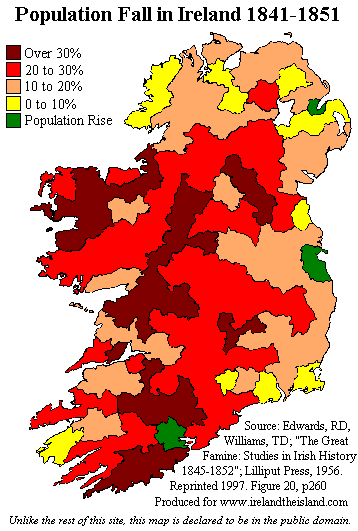St. Patrick’s Day Reflection on the Great Famine of Ireland
March 17, 2015
 While you are preparing your St Patrick’s Day dinner today is a good day to reflect on the history of the Great Famine which effected Ireland for generations to come. The traditional Irish-American Corned Beef and Cabbage dinner is a favorite in my home. Today I as I prepare my St. Patrick’s dinner to share with my family, I reflect on one the key components of the dinner, potatoes, and all that the poor in Ireland suffered for its reliance on the potato as its main source of food.
While you are preparing your St Patrick’s Day dinner today is a good day to reflect on the history of the Great Famine which effected Ireland for generations to come. The traditional Irish-American Corned Beef and Cabbage dinner is a favorite in my home. Today I as I prepare my St. Patrick’s dinner to share with my family, I reflect on one the key components of the dinner, potatoes, and all that the poor in Ireland suffered for its reliance on the potato as its main source of food.
The Great Famine of 1845-1849 is perhaps the most significant event in Ireland’s history. It was a catastrophic event in the history of Europe and the considered the worst famine ever recorded in the world. The Great Famine primarily effected the poor in Ireland, which accounted for 2/3’s of the Irish population. This majority population were also “dangerously dependent on the potato for survival,” and the potato had a limited storage life of one year. The short shelf life made it impossible to compensate from stored crops between good and bad harvests. This set a dangerous precedent for famine in Ireland in the nineteenth century coupled with the British government’s grave disinterest in its closest colony, Ireland.
The land system in Ireland at this time was quite precarious and volatile at the time. Relationships between landlords and tenants were on tenuous terms financially and politically. England’s industrial revolution had had disastrous effects on the many “cottage industries in Ireland in the 1830s and 1840s, especially the weaving and spinning of textiles, and many hundreds of thousands were left without employment,” that supported the working class Irish people. There was little investment being made into the Irish economy, instead, those who could afford to invest invested outside of Ireland in Britain.
From the British government came the sense that “Irish poverty tended to be seen as the result rather of Irish laziness, incompetence, and even immorality.” This attitude is similar to today’s attitude towards poverty in many areas of the globe, including America. The Protestant British government was loathe to help the poor Irish people, the majority of whom were the Catholics.
As the potato blight, caused by the “fungus Phytophthora infestans,” which had been “previously unknown,” arrived in Europe from North America, Ireland needed help from the British government to deal with the agricultural crisis. The tenuous nature of the relationship between Ireland and Britain, added to the disaster, rather than aiding the impoverished people of Ireland who relied on the potato as their main source of sustenance. The consequences were brutal. The economic and social result of the Famine was the decline in population from “2,225,000 in the period 1845–51” to a “probable high of 8,200,000.”

One of the interesting results I noted in my research of the famine was the decline of the Irish (Gaelic) language, which was most prevalent in the areas of Ireland which were predominantly affected by the famine and subsequent emigration from Ireland to escape the effects. Other pressures also attributed to the decline of the language at the same time, including the increased use of the English language in both Catholic and Protestant churches and in education. It makes sense however that a huge decline in population would make a marked difference in the use of the Irish language.
Most distressing but not at all surprising, was the British government’s attitude towards the Irish Famine. Britain took a very laissez-faire stance on the plight of the poor who were suffering the ravages of famine and famine caused disease, yet, the crisis in Ireland was seen by Britain “as a possible threat to the economic prosperity of the United Kingdom.”
Economists shaped the government’s debates on the Famine in Ireland, with a great deal of influence from the ‘political economy’ doctrine of which economist Adam Smith was a “principal proponent.” Smith maintained that a nation’s wealth “could be increased if the market was free from constraints and Government intervention was kept to a minimum.” These principles fit the laissez-faire treatment of the situation in Ireland, that many in the government viewed as “an economy trapped in a spiral of poverty,” creating an inevitable “social disaster” that was convenient in terms of reducing the swiftly growing population, which had contributed to the poverty of Ireland. Appallingly, in this, the British felt that “it made the Government and its officials appear blameless.”
By contrast, to the abysmal response of the British government, the private response to the Famine crises in Ireland was heartening and quite significant, as financial aid came from around the globe. In fact, it is noted “at least £2,000,000 was raised,” from a variety of sources within Ireland and abroad which “cut across religious, national, and economic differences.”
Most maddening in all of this was the fact that as thousands upon thousands starved from the famine, oats, grains and other foods were exported out of Ireland. These crops and other foods that could have fed the poor starving masses in Ireland, yet instead they were sent to feed British and Europeans. Meanwhile the primarily Catholic Irish poor, already brutally oppressed by Britain, lay wasted from famine and disease in the streets as money was made on crops and other foods from Ireland.
This is just a glance at the effects the Great Famine had on Ireland. For more information on the history of the Great Famine visit the Multitext Project in Irish History: Famine.
Watch Sinead O’Connor perform her song Famine on Jools Holland:






